Detector Sounds
This article focuses on sounds made by the Minelab GPX Series detector; specifically mine, which is a GPX 5000.
Although as any good operator will know, it pays to dig all targets, however, at times this is not practical as:
- Some areas are full of trash and it's not practical to recover all targets. You will need to differentiate, at least, between ferrous and non-ferrous targets.
- Hot rocks can sound like good targets.
- Ground noise can be hard to differentiate from deep targets.
In any case, anticipating what the target is, can be useful, increases your aural sensitivity and will hopefully make your detecting experience more enjoyable.
A Word of Explanation
Describing sounds using words is very subjective so what I have here are audio recordings and frequency analysis charts. I obtained these by recording detector sounds through my headphone speakers (so you may also hear rustling sounds and other background noises, even birds tweeting!) using my Anrdoid mobile phone running ProSpec (https://play.google.com/store/apps/details?id=com.digiphd.prospec&hl=en). The charts run left/right over seconds and top/bottom over audio frequency (in kilo Hertz). The darkness of the plot shows the volume. The left-most, shaded, vertical bar indicates the sound volume.
Unfortunately I did change some of the ProSpec settings, in order to suppress extraneous noises, so you will need to focus on the overall plot of the chart (i.e. the darker lines).
Note: Click the Play button (below the chart) to hear the audio. If you see the words "Your browser does not support the audio element" it means you will need to upgrade your browser to something more recent.
You may want to use head/ear phones to listen to these recordings.
Also, once you click the Play button, it may take a moment for the audio to download and play. Each audio file runs for about 10 secs. Please be patient and give it a moment
'Inverted' Gold Signal
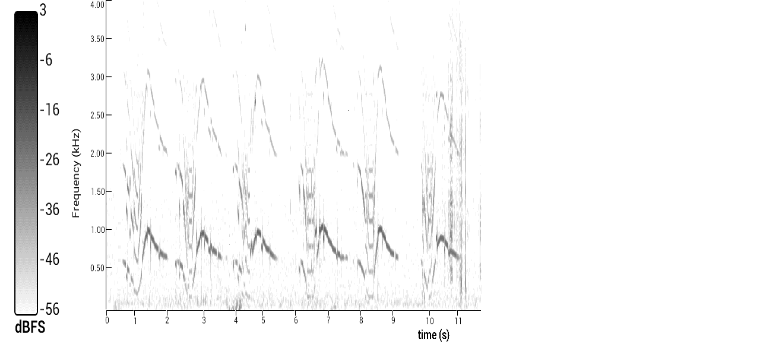
Using a 14" mono coil, this 10gm nugget at 7" gave a good signal that went to strong after the top soil was remove. Only the signal strength changed, not the wave form. Strangely it was an 'inverted' signal (captured after top soil was removed). 'Strange' because compared to the 0.22 bullet casing below, I would have expected this to sound 'normal' and the bullet casing to be 'inverted'.
The 'inverted' (or deep) signal is described by Minelab as a pitch that first falls and then rises.
'Inverted' Ferrous Signal
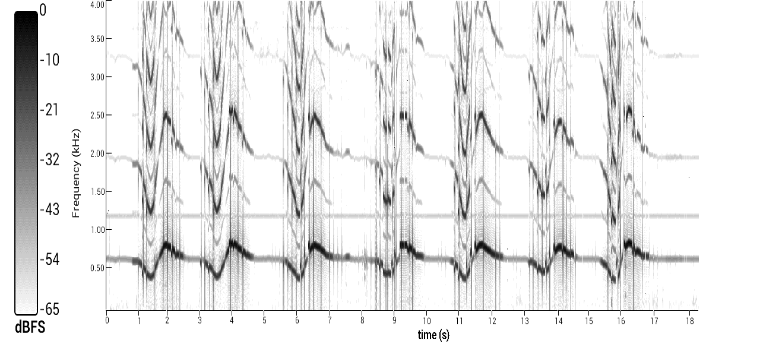
This is the signal from a flattish lump of corroded ferrous material about 1 by 1.5 inches at 14 inches deep.
'Normal' Sound
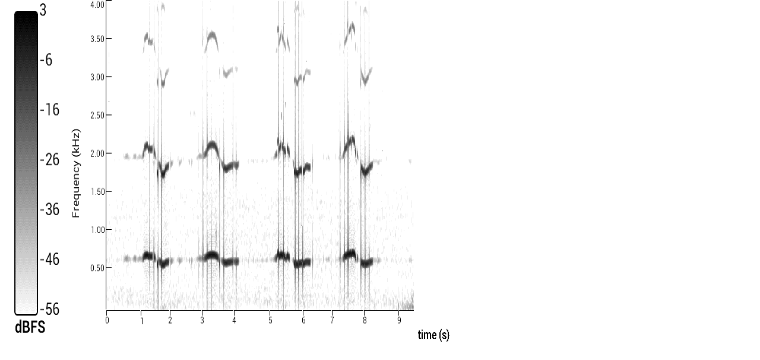
Also using a 14" mono coil, this 0.22 bullet casing at 7" gave a weak signal that went to good/strong after the top soil was removed. Only the signal strength changed, not the wave form. Strangely it was a 'normal' signal (captured after top soil was removed). 'Strange' because compared to the size of the gold target above, I would have expected this to be 'inverted' and the gold to be 'normal'.
Minelab describes a 'normal' signal as a 'rise and fall' pitch.
Gold targets and (brass) bullet casing (also lead bullets and shotgun pallets, etc) sounds are what operators describe as 'smooth and mellow'. It is a rare operator who will claim to be able to differentiate between them; although if you are picking up lots of bullet casings or shotgun pallets (lead), each will sound very similar and a 'new' (smooth and mellow) sound will likely be something different (gold nugget?).
0.6gm buried test piece at 6" with 14" NF round mono
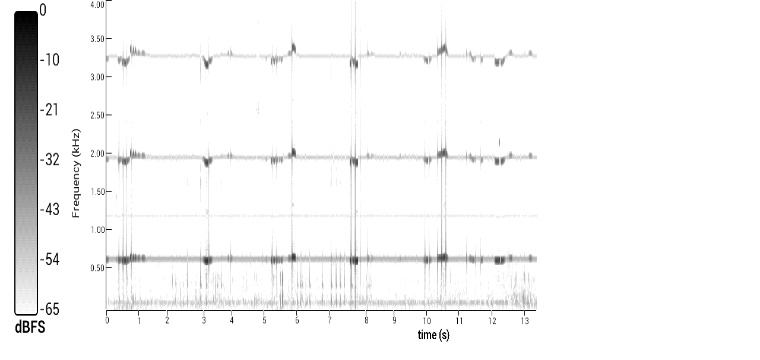
This is a smooth, pebble-like, test 0.6gm nugget, roundish, slightly flattish and about 2 to 3mm across; buried at 15cm (6 inches), and detected using a 14 inch round, mono NF coil. You may want to plug in your heard/ear phones to appreciate this inverted signal.
Buried charcoal (i.e. burnt root)
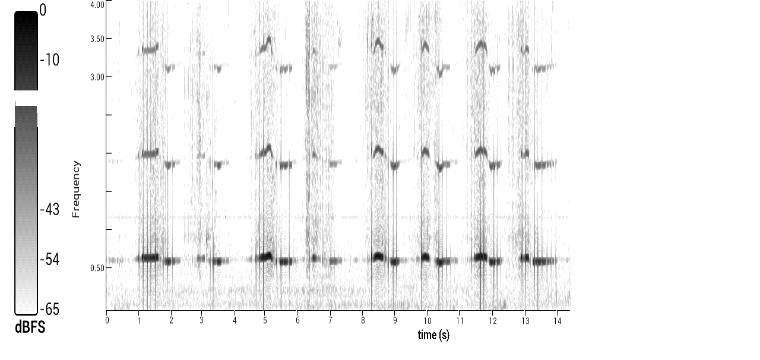
This was a weak signal that turned out to be charcoal from a burnt root. Removal of top soil did little to change the signal strength. Also the target 'moved' as recovery proceeded. Compared to sounds of metallic targets, this charcoal has a very restricted frequency range.
Rusty ferrous file (about 10" long)

This target was a rusty file lying on the surface. The rust was comprehensive but only superficial. If necessary the file could have been used. If the target had much more rust on it a 'scratchy' sound would have been apparent.
Compared to the gold/brass/lead sound, this ferrous sound is very similar, however, some operators claim to be able to differentiate. It is described as less mellow and more higher pitched. The wave form (chart) looks to bear out this subjective description.
Hot rock on the surface
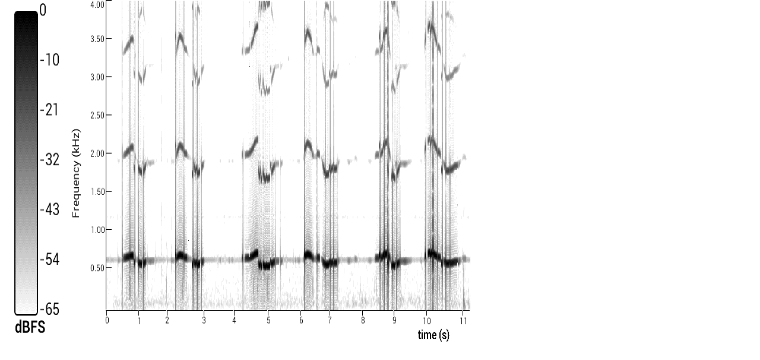
This sound came from a 'hot rock. It was about 6 to 8 inches in size. Upon breaking it open, only about 1/2 inch of it was actually 'hot'.
Most operators agree that some 'hot' rocks sound 'really nice' and can be extremely hard to differentiate from gold/brass/lead. However, this is usually not a problem as they can be easily kicked away.
Final Words
Hopefully you have gained some benefit from looking and listening to the sounds above (did you hear the birdies tweeting?). Please bear in mind that they are only a very small sample (note to self, get more samples) and in reality gold has a large variety of sounds.
It will be best to not focus on any particular sound (above) as 'gospel' for its described type but rather try to appreciate the generic qualities across the described types. Gold (including lead) is often described as having a smooth, mellow sound. Whereas, ferrous metal is often described as having a screechy, higher pitched sound.
The shape and texture of a target also affects the sound. Course gold (as opposed to a smooth, pebble like nugget) will have a more screechy sound. (This may explain why ferrous targets are described a screechy, as they tend to be rusted with a course texture.)
A target with holes or an irregular shape, such as a wriggly piece of wire; or a nugget with holes, can give a wobbly sound.
A broad sound (as in dimensionally spread over the ground) indicates a deep target - is it inverted? Normally, one would expect a deep target to be inverted. A hot ground signal is often broad in one direction and narrower at 90 degrees; try intermediate sweeping angles to determine the broadest and narrowest signals. You may sometimes find 'clay mounds'; circular occurances of clay in otherwise non-clay ground. This sudden change of ground type can also give a 'nice' signal which in this case will be dimensionally the same from all directions. A shallow target will give a dimensionally narrow and aurally distinct entry and exit beep.
It is usually difficult to appreciate the finer audio qualities of a soft or hard to detect target. In any event, listen out for those faint signals. This is best done by focusing on the Threshold which should be set to a faint but audible hum. When a target is detected the threshold changes in volume and pitch (frequency). As they say, look after your pence and the pounds will look after themselves (as in, listen for the faint signals because you will hear the loud ones anyway).
Note. Whilst it is 'interesting' to describe a X gm nugget detected at X inches deep; it is not meaningful as a good comparison of detecting depth because it says nothing in regards shape, texture or orientation of the target. For comparing detecting depth, a consistent target, such as a coin laid flat, should be used. It should be buried and ideally given time, as in months to years, in order to 'mature'. The regolith, or type of ground, and how mineralised it is, is another important factor.
Your detector provides a lot of information in the audio but, to be sure, you should always dig all targets. Tune your hearing to fainter and more subtle audio qualities. You should find more gold that way. And have fun anticipating what your target is - it may make the difference between detecting trashy ground or walking away. Enjoying your hobby is what it's all about.

